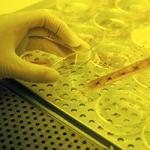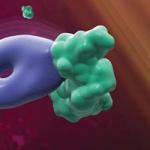
Research Topics
Research Goal
Research in the Natural Products Chemistry Section focuses on the discovery and development of new classes of molecules that are effective in preventing infections by bacterial and viral pathogens with an emphasis on compounds effective against drug-resistant bacteria and enveloped viruses.
Current Research
Our lab carries out interdisciplinary research aimed at the discovery of biologically active natural products, also known as secondary metabolites; seeks to understand basic principles involved in protein-carbohydrate interactions and how these can be exploited to engineer therapeutics; and designs and synthesizes small molecules and peptides that block or can be used to probe the events that lead to viral entry.
Natural products chemistry and antimicrobials
The chemical and biological properties of natural products, or specialized metabolites, have been optimized for millions of years through evolutionary pressures to effect biology and life. Natural products thus represent an ideal starting point for identifying new inhibitors and probes of macromolecular receptors and biological processes. Ongoing projects, approaches, and interests in our lab include isolation and complete structure elucidation of natural products that kill drug resistant bacteria and block virus infection. To elucidate chemical and 3-dimensional structures of inhibitors we rely on multidimensional nuclear magnetic resonance (NMR) and modern spectroscopic techniques. NMR methods are especially powerful because they can be used to directly identify precise targets on proteins, or important structural features of inhibitors that account for activity. A variety of approaches are used to identify targets or determine mechanisms of action, including mutagenesis and genome sequencing, and cell based and functional assays.
Protein-carbohydrate recognition and infectious diseases
Protein-carbohydrate interactions play critical roles in countless biological processes and recognition events ranging from fertilization, inflammation, and trafficking of tumor cells during metastasis. In addition, microbes and many viruses display dense glycan structures, carbohydrate-binding proteins, or both on their outer membranes. We exploit those features by targeting surface glycans with non-human lectins or lectin domains as an approach to inhibit viral infections. To gain a detailed understanding of the interactions leading to protein-carbohydrate recognition, we use glycan profiling, biophysical techniques, viral infectivity assays, and high-resolution structure determination by NMR or S-ray crystallography. Many protein-carbohydrate interactions are multivalent. A larger goal in our research aims to define at a level that would satisfy chemists, how these multivalent interactions take place and how they manifest in specificity and remarkable potency.
Applying our Research
Infectious diseases take an enormous toll on human health. An understanding of the mechanisms that lead to infection by pathogens, at the molecular level and in high-resolution, can explain how inhibitors are able to block infection. This knowledge can be used to develop new medicines for human health.
Need for Further Study
Unanswered questions relevant to the field of antibiotic discovery and carbohydrate recognition:
- Can drug resistant bacteria be killed through non-traditional targets, and are these targets 'druggable'?
- What is the barrier that prevents the vast majority of small molecules to cross the outer membrane of Gram-negative bacteria? Answers to these questions may facilitate development of new antibiotics.
- How do lectins achieve precise specificity, and can we use their architecture to engineer therapeutics?
Biography
- Ph.D., University of California, San Diego, 1995
Selected Publications
- Davison JR, Rajwani R, Zhao G, Bewley CA. The genome of antibiotic-producing colonies of the Pelagophyte alga Chrysophaeum taylorii reveals a diverse and non-canonical capacity for secondary metabolism. Sci Rep. 2023;13(1):11944.
- Marton G, Koenis MAJ, Liu HB, Bewley CA, Buma WJ, Nicu VP. An Artificial Intelligence Approach for Tackling Conformational Energy Uncertainties in Chiroptical Spectroscopies. Angew Chem Int Ed Engl. 2023;62(38):e202307053.
- Bewley CA, Sulikowski GA, Yang ZJ, Bifulco G, Cho HM, Fullenkamp CR. Properties of Configurationally Stable Atropoenantiomers in Macrocyclic Natural Products and the Chrysophaentin Family. Acc Chem Res. 2023;56(4):414-424.
- Zhao G, Kosek D, Liu HB, Ohlemacher SI, Blackburne B, Nikolskaya A, Makarova KS, Sun J, Barry Iii CE, Koonin EV, Dyda F, Bewley CA. Structural Basis for a Dual Function ATP Grasp Ligase That Installs Single and Bicyclic ω-Ester Macrocycles in a New Multicore RiPP Natural Product. J Am Chem Soc. 2021;143(21):8056-8068.
- Rajwani R, Ohlemacher SI, Zhao G, Liu HB, Bewley CA. Genome-Guided Discovery of Natural Products through Multiplexed Low-Coverage Whole-Genome Sequencing of Soil Actinomycetes on Oxford Nanopore Flongle. mSystems. 2021;6(6):e0102021.
Related Scientific Focus Areas




Microbiology and Infectious Diseases
View additional Principal Investigators in Microbiology and Infectious Diseases

Molecular Biology and Biochemistry
View additional Principal Investigators in Molecular Biology and Biochemistry
This page was last updated on Thursday, August 7, 2025